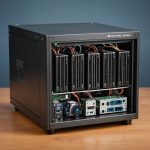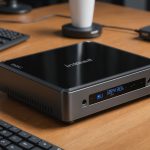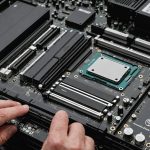Overview of Machine Learning on Edge Devices
In recent years, edge devices have increasingly become pivotal in transforming how machine learning operates, specifically when it comes to real-time data processing. These devices process data on-site, reducing the need to send information back and forth to centralized data centers. This local processing capability catalyses faster response times, making it invaluable in applications requiring instantaneous results, such as autonomous vehicles and smart home systems.
Implementing machine learning models on edge devices presents unique challenges. One primary challenge is the deployment strategies due to the devices’ limited computational resources, such as power constraints and reduced processing power. Creating efficient models that maintain accuracy while fitting these constraints is no small feat.
Also read : Transforming telemedicine: innovative approaches to seamless ai integration
Additionally, ensuring that these models can process data in real-time requires sophisticated optimization strategies to manage latency. The role of edge devices in real-time processing involves striking a delicate balance between accuracy and speed, ensuring that the models respond swiftly without degrading performance. This execution at the edge reduces network bandwidth usage and enhances user privacy by keeping sensitive data within local devices. Thus, edge computing empowers new and exciting applications in machine learning, pushing the boundaries of what’s possible.
Optimizing Models for Limited Hardware
In the realm of machine learning, optimizing models for limited hardware is crucial for efficient deployment. This ensures that models can operate effectively within the constraints of edge devices without compromising performance.
Topic to read : Unlocking the power of ai in advertising: expert strategies for successful campaign management
Techniques for Model Compression
Model optimization often involves techniques such as compression. By reducing model size, devices can handle computations more efficiently, thus addressing resource constraints. These techniques aim to maintain high accuracy levels while minimizing size and power consumption.
Pruning and Quantization Methods
One popular optimization strategy is pruning, where redundant neurons and connections are removed from a network, effectively decreasing size and computational load. Quantization further enhances performance by reducing the numerical precision of model weights, allowing for faster computations and reduced memory usage.
Leveraging Pre-trained Models
Pre-trained models serve as valuable assets in overcoming hardware limitations. By adapting these models through transfer learning, developers can leverage existing, robust architectures, finely tuning them to suit specific tasks. This facilitates efficient deployment on edge devices, saving time and resources while enhancing model performance.
Comprehending and applying these strategies is fundamental to maximising the potential of machine learning applications on limited hardware.
Ensuring Real-Time Processing
For applications leveraging real-time processing on edge devices, maintaining low latency is paramount. This ensures that actions are executed almost instantaneously, enhancing user experience. To achieve this, strategies revolving around performance tuning play a pivotal role. Streamlining inference times involves a combination of hardware and software optimizations. Use specific benchmarks tailored to the deployment environment to identify latency bottlenecks. Adjust network architectures by employing techniques like layer fusion and batch normalization.
Avoiding common pitfalls is crucial in guaranteeing real-time performance. Overloading the system with intricate models can hinder efficiency. It’s essential to strike a balance between model complexity and the computational capabilities of the hardware. To counteract latency issues, implement asynchronous processing and leverage batch processing where feasible. These practices allocate resources more judiciously, aiding in prompt response execution.
Furthermore, utilize hardware acceleration through GPUs or TPUs when available, as they significantly reduce latency compared to CPU-bound operations. Crafting a robust architecture with an eye towards both software and hardware constraints ensures edge devices provide rapid and reliable responses, crucial for applications like autonomous navigation and real-time video analytics.
Data Privacy and Security Considerations
Incorporating machine learning on edge devices brings unique challenges, especially in safeguarding data privacy. As data is processed locally, close to the source, a major concern lies in securing sensitive information while maintaining device efficiency. Ensuring data privacy on these devices involves implementing robust encryption protocols to shield data from potential breaches during operation. This critical step protects user information, reinforcing trust and encouraging technology adoption.
Achieving data security also demands compliance with international and regional regulations, such as GDPR. Following these guidelines not only ensures lawful operations but also enhances the overall credibility of these systems. It’s important to integrate continuous monitoring and security updates to defend against evolving threats, keeping systems resilient and robust against attacks.
Best practices include adopting authentication mechanisms to verify user identity and access, as well as employing secure communication channels. Incorporating these safeguards fosters a multi-layered security posture, essential for mitigating risks.
Ultimately, successfully navigating the security landscape of edge computing requires a delicate balance: providing robust protection without compromising the agility and responsiveness that edge devices promise to deliver in modern machine learning deployments.
Integrating Machine Learning with IoT Systems
Incorporating machine learning with IoT systems stands as a transformative development in technological integration. This combination enhances system intelligence and real-time decision-making. The integration of these two fields allows devices to process data more efficiently, paving the way for innovative applications across various industries.
Frameworks and Tools for Integration
To achieve seamless IoT integration, leveraging specialized frameworks is crucial. Tools like TensorFlow and Edge Impulse facilitate the merging of ML models with IoT systems, while ensuring that deployment is swift and robust. These frameworks simplify the process, allowing developers to focus on crafting intelligent solutions without being bogged down by integration complexities.
Use Cases in Various Industries
The application of machine learning within IoT is broad, extending from smart agriculture—where predictive analytics optimize resource usage—to manufacturing, where real-time monitoring enhances process efficiency. Additionally, in healthcare, integrated systems support patient monitoring, leading to timely interventions.
Designing Scalable IoT Solutions
Ensuring scalability in IoT systems equipped with ML functionalities involves careful system architecture design. It’s imperative to construct architectures that efficiently handle increasing data loads while maintaining performance. Considerations such as modular design and cloud edge synergy play pivotal roles in scaling solutions, ensuring they remain functional despite growth.
Tools and Frameworks for Effective Implementation
In the realm of edge deployment, leveraging the right frameworks and development tools is crucial for effective machine learning implementation. Popular frameworks like TensorFlow Lite and PyTorch Mobile are designed to enable seamless model scaling on resource-constrained devices. They offer developers extensive libraries and pre-built functions that aid in deploying models efficiently without sacrificing performance.
Overview of Popular Frameworks
TensorFlow Lite is specifically optimized for mobile and edge devices, providing a lightweight solution for model inference. Meanwhile, PyTorch Mobile focuses on scalability and ease of use, allowing for customisation and experimentation, which is particularly useful for more complex deployments.
Comparison of Tools for Model Deployment
Choose tools that streamline deployment and management processes. For instance, TensorFlow Lite supports on-device model conversion, making it ideal for dynamic environments. In contrast, PyTorch Mobile offers significant flexibility in handling model architectures and real-time updates, catering to a broad range of use cases.
By utilising these effective frameworks and tools, developers can maintain robust edge deployment setups. This ensures high performance, adaptability to real-world applications, and continuous operation efficiency within the field of edge computing.
Case Studies and Success Stories
Case studies offer valuable insights into the deployment of machine learning on edge devices, showcasing practical applications that yield tangible benefits. These real-world examples illuminate how organizations leverage edge computing to enhance operations and improve outcomes. Typically, success is gauged through metrics like processing speed, energy consumption, and accuracy improvements.
For instance, in the realm of autonomous vehicles, edge devices facilitate rapid data processing. They allow vehicles to make instantaneous decisions while reducing reliance on cloud connectivity. Here, success is measured in reduced response times and increased safety margins.
In manufacturing, machine learning models deployed on edge devices streamline real-time quality control. By processing sensor data locally, facilities can quickly identify defects and adjust production parameters accordingly. Success metrics include reduced defect rates and minimal downtime.
The healthcare sector also benefits significantly. Edge computing aids in patient monitoring, where real-time data processing is crucial. Portable health devices equipped with machine learning algorithms offer timely diagnostics, improving patient outcomes.
These case studies demonstrate that mastering deployment strategies and addressing performance challenges can lead to substantial efficiency gains, supporting the broad spectrum of scenarios where machine learning on the edge thrives.











